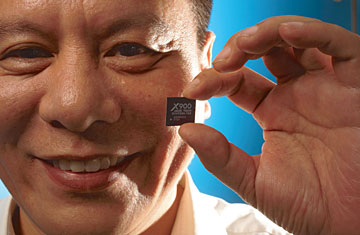
Ouyang says his company's speedy video processors will bring high-quality TV images to mobile phones and other portable devices
Sector: SEMICONDUCTORS
Revenue 2007: $151 MILLION
Profit 2007: N/A
Revenue Growth 2007: 670%
The look and feel of Shanghai Jade Technologies oozes Silicon Valley start-up. The staff consists of 140 young, workaholic geeks drawn either from élite universities, élite companies, or both (the marketing director, who smiles when he calls himself an industry "veteran" at age 26, was a Microsoft programmer before succumbing to the allure of the bootstrap experience). There isn't a tie in sight. And presiding over it all is the committed — some might say bullheaded — CEO, Jack Ouyang. A mathematician with a Ph.D. from Washington University in St. Louis, Mo., Ouyang started Shanghai Jade in 2003 after clashing with the board of WISchip International, a Santa Clara, California-based maker of high-end computer chips that he founded in 1998. It came down, Ouyang says, "to their way or the highway." Ouyang chose the latter — and headed back to his native China.
Today, in a small office building in an industrial park in Shanghai, Ouyang presides over a company in the thick of an industry-wide fight over one of high technology's current sweet spots: computer chips that process video quickly and seamlessly for mobile phones, PDAs and other mobile devices. Instead of the herky-jerky images that are common today, next-generation chips will process very high-quality video, says Ouyang. "It will be like having a TV and a video camera in your pocket — one that works."
When Ouyang first started hunting for venture capital to back his vision, his connection to China — he was born in Changsha in Hunan province — turned out to be critical. With the venture-capital spigot in the U.S. still jammed shut after the dotcom bust and the shock of 9/11, Amoi, one of the leading cell-phone makers in China, backed Ouyang in 2004 with a $3.6 million investment and a commitment to be Shanghai Jade's first customer. A year and a half later, Shanghai Jade had its first product — a chip that Ouyang acknowledges was too sophisticated for the market then. "It was like a very powerful engine for a very expensive sports car," he says, "Not many customers wanted one at that point."
By early 2006 the company had burned through the Amoi seed money, but Softbank Asia agreed to put up another $12 million. With that, Shanghai Jade set about making a less expensive, slightly less powerful version of the first chip. Now they're competing with big players including Freescale Semiconductor and Marvell Technology. What's David's advantage, compared to those Goliaths? "We have a much stronger video processor than they do," Ouyang claims.
That could be standard entrepreneurial hyperbole. Shanghai Jade isn't profitable. But the company has locked in about 20 Chinese manufacturers as customers and is in talks with two industry powerhouses: Nokia and Philips Electronics. After taking in $1 million in revenue this year, Ouyang says the company will introduce a next-generation chip in 2008 that will drive growth to at least $5 million. And after that? "After that," he smiles, "we think we'll have shown that a Silicon Valley-style start-up works in Shanghai, too."